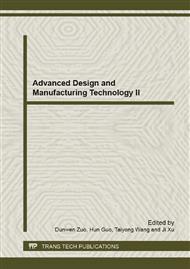p.76
p.80
p.85
p.91
p.97
p.101
p.106
p.110
p.114
Magnetic Test Method Used to Identify Plastic Deformation of Ferromagnetic Material
Abstract:
Metal magnetic memory testing (MMMT) technique is a kind of new NDT technique. It is interested by NDT area in recent years for its own advantages: early diagnosis, preventing sudden fatigue failure of equipments and the testing samples do not need to be magnetized. In order to find out the variation law of the residual magnetic strength of ferromagnetic material processed by different cutting method, axial tension tests about milling and flat surface grinding samples are completed in elastic and plastic deformation phase. The experimental results indicate that the magnetic strength variation law of two kinds of sample makes a great difference in the same deformation phase. The magnetic strength and standard deviation variation law of the grinding and milling samples are almost reverse. But there is a common ground of the two samples that when the material reaches yield phase, turning point occurs on both the residual magnetic strength and standard deviation curve. So we can identify whether there is plastic deformation according to the residual magnetic strength variation law of ferromagnetic material.
Info:
Periodical:
Pages:
97-100
Citation:
Online since:
March 2013
Authors:
Price:
Сopyright:
© 2013 Trans Tech Publications Ltd. All Rights Reserved
Share:
Citation:


